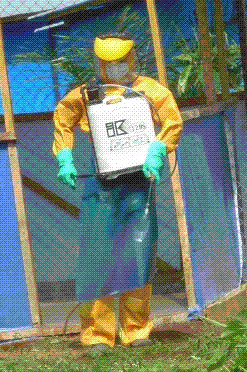Oct
29, 2014
Inside
an Ebola Treatment CenterWe
arrive at the Emergency Ebola Treatment Center unannounced, expecting
to get no
more than a picture of the building and, perhaps, an interview at the
gate. We tell the gatemen we have come to find out more about the
newly-opened center and would like to talk with one of the doctors. We
are asked to wait outside the gate and we discuss whether and how we
can get material for our story as a full PPE-clad worker sprays himself
methodically with chlorine nearby and prepares to enter the facility.
After a short while a lady appears at the gate, smiling and speaking
with an Italian accent. She tells us she is Gina Potella, and is in
charge of the facility. We tell her our mission
and, perhaps, an interview at the
gate. We tell the gatemen we have come to find out more about the
newly-opened center and would like to talk with one of the doctors. We
are asked to wait outside the gate and we discuss whether and how we
can get material for our story as a full PPE-clad worker sprays himself
methodically with chlorine nearby and prepares to enter the facility.
After a short while a lady appears at the gate, smiling and speaking
with an Italian accent. She tells us she is Gina Potella, and is in
charge of the facility. We tell her our mission
"Perhaps you would like to come in and see for yourself?" she says.
We look at each other, startled. This was not quite part of the plan. We had wanted to find out about Ebola and Ebola treatment; we hadn't really bargained on getting close to Ebola.
We go through the gates. The gateman
turns on the chlorine tap for us,
and our temperatures are checked. Pulses racing, we are led into a
small room, where we are asked to take off our shoes and appropriately
sized, heavy duty rubber boots are given to us. Ms Potella, also
wearing boots, but otherwise unprotected, leads us out and through a
passageway with a tub of chlorinated water on the ground, into which we
splash with our boots. We pass through and are told we are now in the
green zone. We find ourselves in an area surrounded with tents, with
hospital workers in red t-shirts busy with various tasks. We are shown
the various sections, including the red zone, the tent containing the
highly symptomatic, confirmed Ebola cases, separated from the green
zone only by a few yards and a mesh net. We move around the green zone
and talk to survivors and workers, ordinary people like ourselves, all
dressed in ordinary clothes. Their stories are below. By the time we
leave the green zone our terror has been somewhat shamed into
submission. We have come close to Ebola and have not been overwhelmed
by it.
If Italians can leave all their comforts and travel thousands of miles
to fight Ebola
here in Sierra Leone and young, pretty Sierra Leonean nurses with
everything to live for can join them day after day, who are we to fear
to spend 30 minutes to record their story. We exit the center after a
final temperature check and chlorine wash.
"Perhaps you would like to come in and see for yourself?" she says.
We look at each other, startled. This was not quite part of the plan. We had wanted to find out about Ebola and Ebola treatment; we hadn't really bargained on getting close to Ebola.
by
Michel Smith
Michel Smith
In the green zone we were shown the medical equipment in use for treatment. Gina Pottela explained that one basic treatment employed on admission is rehydration, which can involve the administration of up to five litres of water per day. When the patient shows symptoms of diarrhoea or vomiting the drug Amudarun is administered.
We were introduced to a number of recuperating patients, who were keen to tell us their experience with Ebola:
Abdulai, another survivor, caught the disease from his wife, who in turn caught it from a female friend in a polygamous marriage where the husband had become infected. Abdulai's wife, six months pregnant, suddenly began to hemorrhage. He carried her, bleeding profusely, to the maternity hospital, where she passed away. Subsequently, he too developed symptoms.
We spoke to two young nurses, Hawanatu and